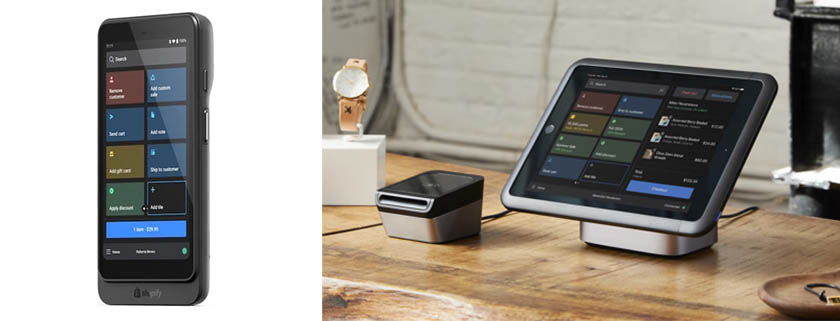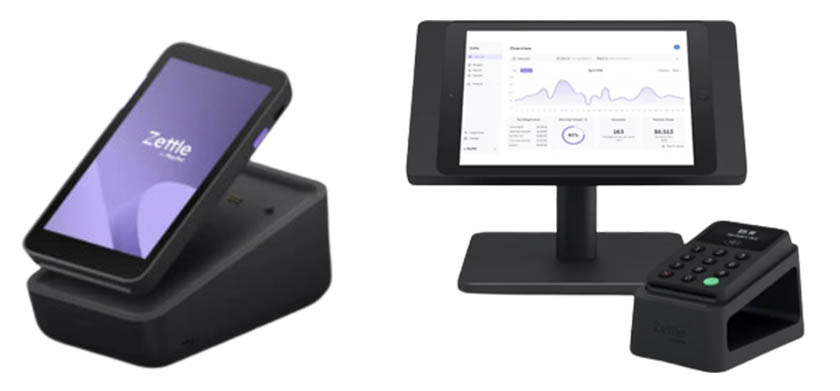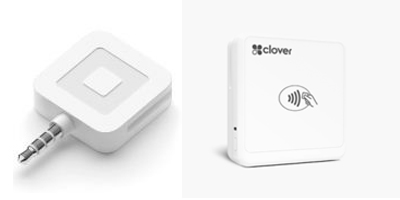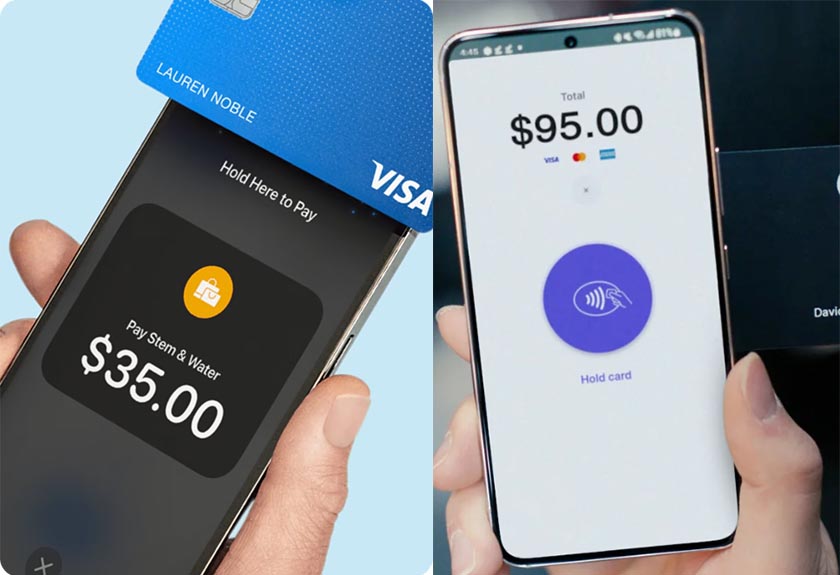In order to accept credit card payments, you will need a merchant account or a payment services provider. Ideally, choose one solution that can handle all of your business’s payment needs – from mobile to online. Choosing the best way to accept credit cards will depend on the type of business you have. For example:
- Brick-and-mortar shops should purchase and set up a point-of-sale (POS) system.
- Mobile businesses will want to use a mobile payment processor with a card reader or one that uses tap-to-pay.
- Online-only businesses need to use an ecommerce platform with a reliable payment processor or payment gateway—with strong security, as online payments pose a higher risk of fraud.
- Delivery-, appointment-, or reservation-based businesses need a secure virtual terminal to process mail order telephone order (MOTO) payments.
- Vendors, suppliers, contractors, and freelancers will need a way to send invoices to their clients and customers.
Once you have chosen a processor, you’ll need to purchase hardware and/or configure your payment software. Let’s take a closer look at our recommended payment processors and get a breakdown of how to accept credit cards in-store, via mobile device, online, over the phone, and via invoice.
What if you saved 25% on payment processor? Whether you accept payments in-person, online, one time or recurring, Helcim has you covered with one free account. |

|
Best All-Around Payment Processors
Accept credit cards via | Monthly fees | Card-present rates | Online rates | Chargeback fees | |
|---|---|---|---|---|---|
✓POS ✓Mobile ✓Ecommerce ✓Virtual Terminal ✓Invoice | $0 | 2.6% + 10 cents | 2.9% + 30 cents | $0 | |
✓POS ✓Mobile ✓Ecommerce ✓Virtual Terminal ✓Invoice | $79 | Interchange + 8 cents | Interchange + 18 cents | $25 | |
✓POS ✓Mobile ✓Ecommerce ✓Virtual Terminal ✓Invoice | $0 | Interchange + 0.30% + 8 cents | Interchange + 0.5% + 25 cents | $0–$15 | |
✓POS ✕Mobile ✓Ecommerce ✓Virtual Terminal ✓Invoice | $0 | 2.7% + 5 cents | 2.9 + 30 cents | $15 | |
✓POS ✓Mobile ✓Ecommerce ✓Virtual Terminal ✓Invoice | $99+ | Interchange + 8 cents | Interchange + 18 cents | $25 | |
You can get a deeper understanding of the different types of fees by checking out our guide to credit card processing fees.
How to Accept Credit Card Payments In-store
If your small business has a fixed physical location, you will need a countertop setup (the kind you see at checkout lanes) to accept credit card payments. This will include a point-of-sale (POS) system with a built-in card reader or attached card payment terminal where customers can present their credit cards to swipe, tap, or dip to process the payment. The checkout counter may accommodate alternative payment methods like contactless and digital wallets.
Did You Know? Transaction fees for accepting in-person payment are the cheapest because presenting the customer’s credit card poses the least risk.
To start accepting payments in-store, you will need to sign up with a POS provider, purchase the necessary hardware, set up your POS system, and then test it. We break down these steps in more detail below.
The first thing you need to do is to sign up with a POS provider, which will provide you with the software and hardware necessary to process credit card payments. Most POS systems already come with a built-in payment processing service or partners with one. Choose a provider that offers competitive pricing, excellent customer service, and a user-friendly interface. Read our in-depth reviews for some popular options like Square for Retail and Lightspeed Retail.
If affordability is a significant factor in your choice of POS provider, there are some free POS software that you can use—you only need to purchase the hardware.
Looking for more options on how to charge a credit card in your retail store? Find more POS alternatives in our list of the leading multichannel POS systems, best retail POS for small businesses, and the top-recommended POS systems and software.
Once you have chosen a POS provider, you will need to purchase the necessary hardware, which may include a card reader, a tablet or computer to run the POS software, and any additional peripherals you may need, such as a cash drawer or receipt printer. The hardware will depend on your business type and the volume of transactions you expect to process.
A countertop card reader can either be built into the POS hardware or needs to be connected to the device where your POS system is installed. This can be a desktop computer, a tablet, or a mobile device. In contrast, a standalone POS terminal is mobile and self-contained, often used by businesses requiring flexibility, such as food trucks or pop-up shops, as they feature an integrated touchscreen, card reader, and, occasionally, a receipt printer, allowing transactions to occur anywhere.
Take a look at some of the hardware options available for a few popular POS providers.

Among Square’s hardware options is a standalone POS terminal (left), which costs $299 and can take orders, accept card payments, and issue receipts, and a register (right), which costs $799 and has a customer-facing display. (Source: Square)

Some of the hardware offered by Shopify POS is its Shopify Go (left), an all-in-one POS device complete with an integrated card reader and barcode scanner—which costs $399, and its Retail Kit (right), which costs $219 without the iPad. (Source: Shopify)

The PayPal Zettle Terminal (right) is a standalone terminal that costs $199 and the PayPal Zettle Store Mini Kit is a countertop retail POS that costs $249 without the iPad. (Source: PayPal)
For more options, read our review of the best credit card readers for small businesses.
Following the instructions from your POS provider, make sure that your system is set up correctly. The initial step is installing the POS software on the device you will use as your point of sale. Most POS providers offer software that is relatively easy to install, and a lot of proprietary hardware comes with the software already installed.
If your POS setup includes a primary POS device and several readers, you might need to connect all the hardware via Bluetooth. You must also configure your account and settings with your business information, payment types, pricing, and tax settings.
You’ll also want to customize your POS system to meet your specific business needs. This step may involve adding product listings, creating categories, and setting up discounts and promotions.
If you signed up with Square, use our tutorial on how to set up Square POS.
After setting up your hardware and software and configuring the settings, test your POS system thoroughly to make sure that everything works. This procedure may involve running several test transactions, checking inventory levels automatically syncs after every transaction from all your payment terminals, and ensuring that your receipts are being generated correctly.
Some POS systems have a sandbox or a test environment that allows the simulation of various actions you will perform on your POS, such as taking payments, creating an inventory, simulating different kinds of transactions, and printing receipts.
How to Accept Credit Cards Using a Mobile Phone
If you want to accept payments outside of a physical storefront location, you need mobile payment tools. You can accept mobile payments via Bluetooth-enabled card readers that sync with a smartphone or a mobile POS device.
Mobile card readers are popular for small businesses selling at farmers markets and restaurants processing tableside or curbside orders and payments.
To start accepting credit card payments using a mobile phone, you will need to sign up with a mobile payment processor, purchase the necessary hardware or a tap-to-pay compatible mobile phone, set up your mobile payment tools, and test it. We go into the details of each step below.
Look for a mobile payment processor that offers the features and pricing that meet your business needs. For better flexibility, look for providers that offer mobile card readers, mobile POS devices, and other mobile payment tools. There are paid services that offer mobile payment processing, but there are free ones as well.
Read our guide on the best mobile credit card processors to find the right one for your business.
To accept credit card payments using your mobile phone, you will need either a card reader to connect to your phone or a tap-to-pay feature.
Using a Card Reader
Mobile credit card processors have card readers that can connect to your phone to pass the card information to your mobile POS app. These could be as small as a dongle that syncs to your smartphone or as elaborate as an entire POS system.

Square’s magstripe reader (left) comes free for the first one and $10 for the next, while the Clover Go card reader (right) costs $49. (Source: Square and Clover)
Some readers, like Square’s free magstripe reader, connect to your phone’s audio jack and allow you to swipe cards for payment. NFC card readers like the Clover Go card reader, connect to your phone via Bluetooth, allowing you to tap, dip, or swipe cards to process payments.
Make sure the card reader you purchase is compatible with your mobile phone. Check out our guides:
Using tap to pay
Some mobile payment processors allow you to use an NFC-capable phone and turn it into an NFC card reader by offering a “tap to pay” feature. This feature allows you to accept credit card payments without buying additional hardware.

Square (left) and Stripe (right) both allow you to accept payments via Tap to Pay on iPhone and Android. (Source: Square and Stripe)
Some providers that offer a tap-to-pay feature are PayPal Zettle, Square, Clover, and Shopify POS. Most processors with tap-to-pay features only have it available on iPhones; Stripe and Square are among the few providers offering tap-to-pay on Android. Check that the tap-to-pay feature is compatible with your mobile phone.
Read our guide to tap to pay to know more about what it is and how it works.
Different mobile payment processors will have different steps in setting up your mobile payment tools. The first step will typically involve downloading and installing a mobile app provided by your payment processor, which will serve as your mobile POS system.
Once the app is installed, you’ll need to connect your hardware, such as a mobile card reader, to your mobile phone via Bluetooth or another connection. Your payment processor will provide you with instructions on how to connect your hardware.
If you prefer not to purchase additional hardware and use the tap-to-pay feature, it often only requires enabling it in your mobile app. Check with your provider for specific instructions on how to activate this feature. Also, keep in mind that the transaction rates of providers may differ depending on the payment method. Find out the processing fees for using tap to pay on your mobile to accept payments.
Configure your app based on your preferences and business needs. Enter any necessary business information, such as your business name, address, tax identification number, and payment details for your payouts. If your mobile app allows you to create your own product catalog, set it up and enter your product details.
Conduct a thorough test of your system to ensure that everything is working as it should. This step may involve running several test transactions, checking inventory levels, and ensuring your receipts are correctly generated.
How to Accept Credit Cards on Your Website
One of the ways to accept credit cards online is through an ecommerce platform or online shop. Some platforms have their own built-in payment processor, like Shopify, or you may sign up with a payment processor that operates online, a payment service provider (PSP), or a merchant account services provider. You’ll want to remember that online payments are more prone to fraud.
According to a recent study, online payment fraud costs are expected to exceed $343 billion between 2023 and 2027. Physical goods account for nearly 50% of all fraudulent online payments. So, small retailers that sell physical goods online should be sure they have excellent fraud protection in place and learn how to prevent chargebacks.
Here are the steps on how to accept credit cards on your website:
- Choose an ecommerce platform or a payment gateway
- Set up your website and test its capability to accept payments
- Secure your website
We go into more detail in our comprehensive guide on how to accept credit card payments Online.
How to Accept Credit Cards Over the Phone
Businesses that allow their customers to place their orders by calling in, emailing, or texting (MOTO payments) will need the capability to accept credit card payments over the phone. This is often applicable for delivery-, appointment-, and reservation-based businesses.
To accept credit card payments over the phone, you will need to sign up with a payment processor that provides a virtual terminal. Some providers have web-based virtual terminals while others have apps where you can enter the transaction amount and card details to process the payment.
Here is a quick overview of the steps on how to accept credit card payments over the phone:
- Sign up with your chosen virtual terminal provider
- Set up your account and virtual terminal
- Process payments according to your provider’s instructions
How to Accept Credit Card Payments Through an Invoice
Some small businesses often receive payments by sending invoices to their customers. A few examples of these businesses are vendors, suppliers, contractors, and freelancers. Many B2B payments are also collected by sending an invoice.
To send an invoice with the ability to accept credit card payments, you will need to sign up with a payment processor that offers invoicing. Here is a general flow of how you can accept payments by sending an invoice:
- Create an invoice according to your payment processor’s instructions
- Send it to your customer
- Your customer clicks a link in the invoice that brings them to a payment page
- Your customer enters their credit card information and clicks pay
- The invoice will be marked as paid on your end and the amount will be credited to your account
Two of the most popular invoicing platforms are Square and QuickBooks. Learn how to send a Square invoice or how to create and send invoices in QuickBooks Online.
Get a Personalized Recommendation
How to Accept Credit Cards Frequently Asked Questions (FAQs)
Here are the answers to some of the most common questions about accepting credit cards.
You do not need a merchant services account to accept credit card payments. If you want to start accepting credit card payments right away, payment service providers tend to have the shortest turnaround time. All you need to do is sign up on their website and connect an active bank account.
The actual processing fees you pay will depend on your business type, sales volume, and the types of cards you accept. So, there is no one-size-fits-all fee. But, if you budget from 1% to 4% for processing fees, you’ll rarely be surprised.
You may be able to use your existing gift cards with a new merchant services provider, but it depends on the network your gift cards operate on. Check with your current processor to find out the network. If your new processor uses the same network, you can probably keep your current gift cards.
You can typically accept online credit card payments with no upfront cost via a payment services provider like Square or Stripe. The provider will retain their processing fees from the transaction and send the remaining funds to your business bank account.
The cheapest way to accept credit card payments depends on your business size. If you process under $10,000/month, consider flat-rate processors like Square with no monthly fees. For over $10,000/month, look into interchange-plus pricing. Payment Depot, Helcim, and Stax offer this cost-effective option.
Bottom Line
The ability to accept credit cards is a must for every business, whether you need to accept payments in-person, online, with the use of a mobile phone, over the phone, or by sending an invoice. Getting set up to accept credit cards can be easy. The hard part is knowing you are getting a good rate and signing up with a company that offers the support you can rely on.
If you’re a new business, Square offers an affordable and immediate way to accept credit card payments in-person through Square’s POS app, online through Square Online’s free store, or through Square Invoices. Square’s flat-rate fees are transparent and offer good value for new businesses or occasional sellers. Create a free account today.